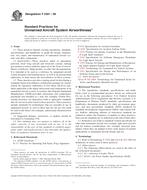Wir benötigen Ihre Einwilligung zur Verwendung der einzelnen Daten, damit Sie unter anderem Informationen zu Ihren Interessen einsehen können. Klicken Sie auf "OK", um Ihre Zustimmung zu erteilen.
ASTM F2501-06
Standard Practices for Unmanned Aircraft System Airworthiness (Withdrawn 2015)
Automatische name übersetzung:
Standard Practices for Unmanned Aircraft System der Lufttüchtigkeit (Withdrawn 2015)
NORM herausgegeben am 1.3.2006
Informationen über die Norm:
Bezeichnung normen: ASTM F2501-06
Anmerkung: UNGÜLTIG
Ausgabedatum normen: 1.3.2006
SKU: NS-54003
Zahl der Seiten: 9
Gewicht ca.: 27 g (0.06 Pfund)
Land: Amerikanische technische Norm
Kategorie: Technische Normen ASTM
Die Annotation des Normtextes ASTM F2501-06 :
Keywords:
airframe, airworthiness, aviation, avionics, certification, communication, data link, electromagnetic compatibility, electromagnetic interference, equivalent level of safety, Federal Aviation Administration, flight testing, fuel, materials, navigation, payload, power, propulsion, reliability, sense and avoid, software, standard, UAS, UAV, unmanned aircraft, unmanned aircraft system, unmanned aviation, ICS Number Code 49.020 (Aircraft and space vehicles in general)
Ergänzende Informationen
| Significance and Use | ||||||||||||||||||
|
Designing, manufacturing, testing, and maintaining an unmanned aircraft system to comply with industry standards and recommended practices supports development of a certification package that helps ensure its reliability and can lead to its airworthiness certification. Government aviation authorities’ airworthiness certification processes exist to provide some level of assurance that critical systems will operate reliably and pose minimal risk to persons and property. The use of proven standards and practices in the design, manufacture, and test of these systems, especially for the mission critical components, contributes to this goal, as well as streamlining the certification process and simplifying the system test requirements. While developing to a set of standards and practices will not guarantee certification, the ability to show compliance with established standards provides the basis for a well-documented certification approval package. Compliance with established standards and practices also provides assurance that a given component will function as intended in the specified environment and conditions. The standards cited in these practices have been developed by recognized standards-developing agencies; some are accepted by government aviation authorities as an acceptable means of compliance with airworthiness requirements. By their inclusion in these practices, they are considered to be consensus-based for unmanned aircraft-related purposes. |
||||||||||||||||||
| 1. Scope | ||||||||||||||||||
|
1.1 These practices identify existing regulations, standards, specifications, and handbooks to guide the design, manufacture, test, repair, and maintenance of unmanned aircraft systems and their components. 1.2 ApplicabilityThese practices apply to unmanned, powered, fixed wing aircraft and rotorcraft systems seeking government aviation authority approval in the form of airworthiness certificates, flight permits, or other like documentation. It is intended to be used as a reference by unmanned aircraft system designers and manufacturers, as well as by procurement authorities, to help ensure the airworthiness of these systems. 1.3 These practices provide a starting point for developing a standards-based airworthiness certification package for consideration by regulatory authorities. It lists those top-level standards applicable to the major subsystems and components of an unmanned aircraft system. It assumes that Original Equipment Manufacturer (OEM)-provided subsystems and components, purchased and installed as a unit (for example, Global Positioning Systems), are themselves built to applicable standards that are not necessarily listed in these practices. These practices include standards for technologies that are currently in use in unmanned aircraft, as well as those that are not yet, but could be used in the future (for example, radioisotope thermoelectric generators). 1.4 Suggested changes, corrections, or updates should be forwarded to Committee F38. 1.5 This standard does not purport to address all of the safety concerns, if any, associated with its use. It is the responsibility of the user of this standard to establish appropriate safety and health practices and determine the applicability of regulatory limitations prior to use. |
||||||||||||||||||
| 2. Referenced Documents | ||||||||||||||||||
|
Empfehlungen:
Aktualisierung der technischen Normen
Wollen Sie sich sicher sein, dass Sie nur die gültigen technischen Normen verwenden?
Wir bieten Ihnen eine Lösung, die Ihnen eine Monatsübersicht über die Aktualität der von Ihnen angewandten Normen sicher stellt.
Brauchen Sie mehr Informationen? Sehen Sie sich diese Seite an.




 Cookies
Cookies
